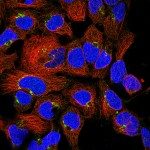Lien vers Pubmed [PMID] – 12383347
Traffic 2002 Nov;3(11):810-21
PrP(C) is a glycosylphosphatidylinositol-anchored protein expressed in neurons as well as in the cells of several peripheral tissues. Although the normal function of PrP(C) remains unknown, a conformational isoform called PrP(Sc) (scrapie) has been proposed to be the infectious agent of transmissible spongiform encephalopathies in animals and humans. Where and how the PrP(C) to PrP(Sc) conversion occurs in the cells is not yet known. Therefore, dissecting the intracellular trafficking of the wild-type prion protein, as well as of the scrapie isoform, can be of major relevance to the pathogenesis of the diseases. In this report we have analyzed the exocytic pathway of transfected mouse PrP(C) in thyroid and kidney polarized epithelial cells. In contrast to the majority of glycosylphosphatidylinositol-anchored proteins, we found that PrP(C) is localized mainly on the basolateral domain of the plasma membrane of both cell lines. This is reminiscent of the predominant somatodendritic localization found in neurons. However, similarly to apical glycosylphosphatidylinositol-proteins, PrP(C) associates with detergent-resistant microdomains, which have been suggested to have a role in apical sorting of glycosylphosphatidylinositol-proteins, as well as in the conversion process of PrP(C) to PrP(Sc). In order to discriminate whether detergent-resistant microdomains have a direct role in PrP(Sc) conversion, or whether they are involved in the transport of the protein to the site of its conversion, we have examined the effect of disruption of detergent-resistant microdomain association on PrP(C) intracellular traffic. Consistent with the unusual basolateral localization of this glycosylphosphatidylinositol-linked protein, our data exclude a classical role for detergent-resistant microdomains in the post-trans-Golgi network sorting and transport of PrP(C) to the plasma membrane.

